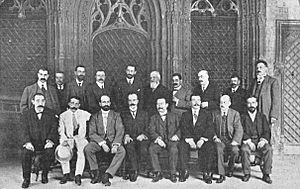Commonwealth of Catalonia facts for kids
Quick facts for kids
Commonwealth of Catalonia
|
|||||||||||||||||||||
|---|---|---|---|---|---|---|---|---|---|---|---|---|---|---|---|---|---|---|---|---|---|
| 1914–1925 | |||||||||||||||||||||
| Capital | Barcelona | ||||||||||||||||||||
| Common languages |
|
||||||||||||||||||||
| Government | Federation of provinces | ||||||||||||||||||||
| President | |||||||||||||||||||||
|
• 1914–1917
|
Enric Prat de la Riba (first) | ||||||||||||||||||||
|
• 1924–1925
|
Alfons Sala (imposed) (last) | ||||||||||||||||||||
| Historical era | Bourbon Restoration | ||||||||||||||||||||
|
• Established
|
6 April 1914 | ||||||||||||||||||||
|
• Primo de Rivera coup d'état
|
13 September 1923 | ||||||||||||||||||||
|
• Disestablished
|
20 March 1925 | ||||||||||||||||||||
|
|||||||||||||||||||||
The Commonwealth of Catalonia (called Mancomunitat de Catalunya in Catalan) was like a special council made up of leaders from the four areas (provinces) of Catalonia. It was created in 1914 and was a big step for Catalonia. It was later stopped in 1925 during a time when Spain was ruled by a dictator named Miguel Primo de Rivera.
Even though it mostly handled administrative tasks, like managing roads or schools, it was very important. It was the first time since 1714 that the Spanish government officially recognized Catalonia's unique identity and its unity as a region. The Commonwealth helped create many public services, especially in health, culture, and education. It also strongly supported the Catalan language.
Contents
How the Commonwealth Started
People in Catalonia really wanted the Commonwealth to be formed. They voted for it in October 1913. The lower house of the Spanish Parliament agreed to create it, but with less power than people hoped for. The upper house, the Spanish Senate, never fully approved it.
However, on December 18, 1913, the king signed a law. This law allowed all Spanish provinces to join together into groups called "commonwealths." Catalonia was the only region that actually formed one. This was a big moment for Catalonia.
Leading the Commonwealth
The first President of the Commonwealth of Catalonia was Enric Prat de la Riba. After him, the architect Josep Puig i Cadafalch became president. Both were from a political group called the Lliga Regionalista.
They worked hard to build better roads, ports, and water systems. They also improved railways, telephone services, and healthcare. The Commonwealth also helped farmers grow more food and trees. They brought in new technology and improved schools. They especially focused on teaching skills needed for Catalonia's industries.
Why the Commonwealth Ended
The Commonwealth was dissolved and made illegal on March 20, 1925. This happened during the time when Miguel Primo de Rivera was the dictator of Spain.
How the Commonwealth Was Organized
The Commonwealth's main group was called the Assembly. It had 36 members from the Province of Barcelona. The Provinces of Tarragona, Girona, and Lleida each had 20 members.
On April 6, 1914, this Assembly chose Enric Prat de la Riba as the first president. Besides the Assembly and the president, there was also an Executive Council. This council had two members from each province.
What the Commonwealth Left Behind
The Commonwealth created many important cultural and scientific groups. Most of these still exist today! Their goal was to make the Catalan language and culture more respected.
Some of these important places include:
- The Institut d'Estudis Catalans (Institute of Catalan Studies)
- The Biblioteca de Catalunya (Library of Catalonia)
- The Escola Industrial (Industrial School)
- The Escola Superior de Belles Arts (College of Fine Arts)
- The Escola del Treball (College of Industry)
Prat de la Riba also started the Escola de l'Administració Local (School of Local Administration). He made it a rule that people working for the Catalan government had to have studied there.
Another very important project was supporting the work of Pompeu Fabra. He was the main person responsible for creating the modern Catalan writing system and its standard rules.
In 1919, the Commonwealth proposed a plan for Catalonia to govern itself, called a Statute of Autonomy. This plan suggested Catalonia should have its own parliament, government, and control over its money. It also explained what powers the Spanish government would keep and what powers Catalonia would have. The Spanish government rejected this plan. However, it became a key idea for the later 1932 Statute of Autonomy.
See also
 In Spanish: Mancomunidad de Cataluña para niños
In Spanish: Mancomunidad de Cataluña para niños
- Generalitat de Catalunya
- Catalan Republic (1931)
- Statute of Autonomy of Catalonia of 1932
- List of presidents of the Government of Catalonia




